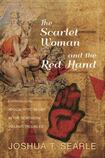
The picket of Harryville chapel, in Ballymena, beginning in the autumn of 1997, was one of the most disturbing episodes of the latter years of the Troubles. For 20 months, during protests about restrictions on the right to parade, loyalists besieged Catholics on their way into Mass, roaring sectarian abuse, grunting like pigs and trying to break through the line of RUC officers that held them back.
One night that I was there with a photographer, to report on these events, a police officer approached and advised us to keep our distance. “They’d tear you limb from limb,” he said. The Belfast Pentecostal pastor Alan Campbell came to the Co Antrim town to preach about the picket. This was, he said, “the ancient battle between the true church, Protestantism and the Whore, the Beast and the Baal worshippers within Catholicism”.
The author of The Scarlet Woman and the Red Hand, Joshua T Searle, describes Campbell as "one of the most outspoken British-Israelite evangelicals in Northern Ireland" and quotes a sermon he preached on Shankill Road in Belfast in 1987: "We Ulster people are . . . the literal flesh and blood seed and descendants of the patriarchs Abraham, Isaac and Jacob . . . We are the seed of Israel . . . of the 10 tribes."
Searle’s book takes its title from the Revelation of John the Divine; its cover shows the Scarlet Woman herself, riding on the beast and “decked with gold and precious stones and pearls and having a golden cup in her hand full of abominations and filthiness of her fornication”.
This is the whore of Babylon, and she, to Northern Protestant apocalyptic evangelicals of a certain twist is, simply, the Catholic Church. The Rev Ian Paisley infamously denounced the pope in the European Parliament as “the anti-Christ”.
For those unfamiliar with the last book of the New Testament, Searle paraphrases the imagery and symbolism that characterise it: “Four terrifying horsemen bringing death and destruction in their wake . . . anguished scenes of people crying out to the rocks to crush them to death . . . torrents of blood flooding the earth . . . hordes of demonic locusts rising out of a dark abyss and smiting Earth’s anguished inhabitants . . . a ferocious dragon, the sweep of whose tail sets one-third of the stars in the firmament careening off their course . . . ”
Friedrich Nietzsche described the Revelation as “the most rabid outburst of vindictiveness in all recorded history”. But the Free Presbyterian minister Ivan Foster has noted briskly that the book contains “much that is eminently practical” and that it provides “a résumé of the events that will mark the end of the age”.
Campbell saw the Troubles ending, like the world, only by divine intervention. “Just as William of Orange . . . delivered God’s people . . . by the overthrow of priestcraft, popery and tyrannised power, so in like manner He who is David’s greater Son is coming again to cut short the days of tribulation, to save His own elect people and destroy the Mystery Babylon.”
According to the prophecy of Zechariah, God is liable to smite those who are not saved with a flesh-eating disease that causes their tongues and eyes to rot in their sockets. All very agreeable to those with an advanced taste for vengeance.
Searle is a Baptist theologian from the kindlier side of evangelism. He preaches a Christianity that has as its goal the building of “the peaceable kingdom” on Earth as in heaven.
He is at pains to highlight the fact that alongside those who preached through the Troubles that deliverance could come for the selected few only from God’s violent intervention, there were other evangelicals who believed that their vocation lay in endeavouring to tackle social injustice.
For him, “apocalyptic eschatology is the language of human hope”. He quotes Kierkegaard’s idea that human beings are driven by “a passion for the possible”. He draws attention to the imagery in Revelation of redemption, of pearly gates and rivers of healing waters and a tree of life. He describes the thinking of the Evangelical Contribution on Northern Ireland, which quietly challenged those preaching Armageddon as the talks that led to the Belfast Agreement gathered pace.
This is an adapted PhD thesis. Were the scaffolding of Searle’s scholarship removed, a fascinating book might emerge. As things stand, the ordinary reader will be seriously tested.
There is the usual snootiness about other disciplines and carefully constructed putdowns of other scholars. There is also a wealth of philosophical research, as well as a trawl of the back catalogue of the likes of the Protestant Telegraph, the Revivalist, the Orange Standard and Combat. The bibliography ranges from Aquinas to Heidegger to Sartre to Wittgenstein.
At times it seems that such scholarship is hardly justified by some of the bigots to whose pronouncements it is applied. Clearly, some of these simply plundered the Bible for its plentiful supply of godly ire and blood-dimmed tides, the better to stir up fear. Readers with an interest in evangelism and apocalyptic ideas in the context of the northern conflict, however, will find in Searle an intelligent and humane guide.
Susan McKay, a former northern editor of the Sunday Tribune, is the author of Northern Protestants: An Unsettled People and Bear in Mind These Dead

